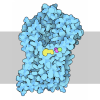[English] 日本語
 Yorodumi
Yorodumi- PDB-9e3q: Cryo-EM structure of the mouse P2X7 receptor in the apo closed state -
+ Open data
Open data
- Basic information
Basic information
| Entry | Database: PDB / ID: 9e3q | |||||||||
|---|---|---|---|---|---|---|---|---|---|---|
| Title | Cryo-EM structure of the mouse P2X7 receptor in the apo closed state | |||||||||
 Components Components | P2X purinoceptor 7 | |||||||||
 Keywords Keywords | MEMBRANE PROTEIN / Ion Channel / Ligand-Gated Ion Channel / P2X Receptor / P2XR / Allosteric Antagonist / Agonist | |||||||||
| Function / homology |  Function and homology information Function and homology informationPlatelet homeostasis / The NLRP3 inflammasome / Elevation of cytosolic Ca2+ levels / positive regulation of lymphocyte apoptotic process / positive regulation of bleb assembly / NAD transport / phagolysosome assembly / phospholipid transfer to membrane / lymphocyte apoptotic process / gamma-aminobutyric acid secretion ...Platelet homeostasis / The NLRP3 inflammasome / Elevation of cytosolic Ca2+ levels / positive regulation of lymphocyte apoptotic process / positive regulation of bleb assembly / NAD transport / phagolysosome assembly / phospholipid transfer to membrane / lymphocyte apoptotic process / gamma-aminobutyric acid secretion / plasma membrane organization / extracellularly ATP-gated monoatomic cation channel activity / pore complex assembly / positive regulation of interleukin-1 alpha production / purinergic nucleotide receptor activity / positive regulation of gamma-aminobutyric acid secretion / plasma membrane phospholipid scrambling / negative regulation of cell volume / collagen metabolic process / positive regulation of prostaglandin secretion / T cell apoptotic process / bleb assembly / response to fluid shear stress / mitochondrial depolarization / vesicle budding from membrane / ceramide biosynthetic process / positive regulation of T cell apoptotic process / programmed cell death / prostaglandin secretion / positive regulation of ossification / cellular response to dsRNA / cell volume homeostasis / glutamate secretion / positive regulation of glutamate secretion / negative regulation of bone resorption / positive regulation of macrophage cytokine production / skeletal system morphogenesis / phospholipid translocation / response to zinc ion / response to ATP / positive regulation of mitochondrial depolarization / positive regulation of NLRP3 inflammasome complex assembly / sodium channel activity / protein homotrimerization / T cell homeostasis / positive regulation of calcium ion transport into cytosol / membrane protein ectodomain proteolysis / protein secretion / synaptic vesicle exocytosis / response to electrical stimulus / monoatomic cation transport / potassium channel activity / positive regulation of bone mineralization / response to mechanical stimulus / T cell proliferation / negative regulation of MAPK cascade / extrinsic apoptotic signaling pathway / release of sequestered calcium ion into cytosol / sensory perception of pain / homeostasis of number of cells within a tissue / reactive oxygen species metabolic process / positive regulation of glycolytic process / positive regulation of interleukin-1 beta production / positive regulation of protein secretion / mitochondrion organization / response to bacterium / neuromuscular junction / lipopolysaccharide binding / establishment of localization in cell / protein catabolic process / T cell mediated cytotoxicity / response to calcium ion / protein processing / positive regulation of interleukin-6 production / positive regulation of T cell mediated cytotoxicity / cell morphogenesis / cell-cell junction / calcium ion transport / presynapse / MAPK cascade / signaling receptor activity / channel activity / response to lipopolysaccharide / gene expression / postsynapse / positive regulation of MAPK cascade / defense response to Gram-positive bacterium / positive regulation of apoptotic process / response to xenobiotic stimulus / inflammatory response / external side of plasma membrane / neuronal cell body / synapse / mitochondrion / ATP binding / identical protein binding / membrane / plasma membrane Similarity search - Function | |||||||||
| Biological species |  | |||||||||
| Method | ELECTRON MICROSCOPY / single particle reconstruction / cryo EM / Resolution: 2.53 Å | |||||||||
 Authors Authors | Oken, A.C. / Turcu, A.L. / Vazquez, S. / Mansoor, S.E. | |||||||||
| Funding support |  United States, 2items United States, 2items
| |||||||||
 Citation Citation |  Journal: Nat Commun / Year: 2025 Journal: Nat Commun / Year: 2025Title: A polycyclic scaffold identified by structure-based drug design effectively inhibits the human P2X7 receptor. Authors: Adam C Oken / Andreea L Turcu / Eva Tzortzini / Kyriakos Georgiou / Jessica Nagel / Franka G Westermann / Marta Barniol-Xicota / Jonas Seidler / Ga-Ram Kim / So-Deok Lee / Annette Nicke / ...Authors: Adam C Oken / Andreea L Turcu / Eva Tzortzini / Kyriakos Georgiou / Jessica Nagel / Franka G Westermann / Marta Barniol-Xicota / Jonas Seidler / Ga-Ram Kim / So-Deok Lee / Annette Nicke / Yong-Chul Kim / Christa E Müller / Antonios Kolocouris / Santiago Vázquez / Steven E Mansoor /      Abstract: The P2X7 receptor is an ATP-gated ion channel that activates inflammatory pathways involved in diseases such as cancer, atherosclerosis, and neurodegeneration. However, despite the potential benefits ...The P2X7 receptor is an ATP-gated ion channel that activates inflammatory pathways involved in diseases such as cancer, atherosclerosis, and neurodegeneration. However, despite the potential benefits of blocking overactive signaling, no P2X7 receptor antagonists have been approved for clinical use. Understanding species-specific pharmacological effects of existing antagonists has been challenging, in part due to the dearth of molecular information on receptor orthologs. Here, to identify distinct molecular features in the human receptor, we determine high-resolution cryo-EM structures of the full-length wild-type human P2X7 receptor in apo closed and ATP-bound open state conformations and draw comparisons with structures of other orthologs. We also report a cryo-EM structure of the human receptor in complex with an adamantane-based inhibitor, which we leverage, in conjunction with functional data and molecular dynamics simulations, to design a potent and selective antagonist with a unique polycyclic scaffold. Functional and structural analysis reveal how this optimized ligand, termed UB-MBX-46, interacts with the classical allosteric pocket of the human P2X7 receptor with subnanomolar potency and high selectivity, revealing its significant therapeutic potential. | |||||||||
| History |
|
- Structure visualization
Structure visualization
| Structure viewer | Molecule:  Molmil Molmil Jmol/JSmol Jmol/JSmol |
|---|
- Downloads & links
Downloads & links
- Download
Download
| PDBx/mmCIF format |  9e3q.cif.gz 9e3q.cif.gz | 308.1 KB | Display |  PDBx/mmCIF format PDBx/mmCIF format |
|---|---|---|---|---|
| PDB format |  pdb9e3q.ent.gz pdb9e3q.ent.gz | 250.7 KB | Display |  PDB format PDB format |
| PDBx/mmJSON format |  9e3q.json.gz 9e3q.json.gz | Tree view |  PDBx/mmJSON format PDBx/mmJSON format | |
| Others |  Other downloads Other downloads |
-Validation report
| Summary document |  9e3q_validation.pdf.gz 9e3q_validation.pdf.gz | 1.6 MB | Display |  wwPDB validaton report wwPDB validaton report |
|---|---|---|---|---|
| Full document |  9e3q_full_validation.pdf.gz 9e3q_full_validation.pdf.gz | 1.6 MB | Display | |
| Data in XML |  9e3q_validation.xml.gz 9e3q_validation.xml.gz | 69.6 KB | Display | |
| Data in CIF |  9e3q_validation.cif.gz 9e3q_validation.cif.gz | 104.1 KB | Display | |
| Arichive directory |  https://data.pdbj.org/pub/pdb/validation_reports/e3/9e3q https://data.pdbj.org/pub/pdb/validation_reports/e3/9e3q ftp://data.pdbj.org/pub/pdb/validation_reports/e3/9e3q ftp://data.pdbj.org/pub/pdb/validation_reports/e3/9e3q | HTTPS FTP |
-Related structure data
| Related structure data |  47494MC  9e3mC  9e3nC  9e3oC  9e3pC M: map data used to model this data C: citing same article ( |
|---|---|
| Similar structure data | Similarity search - Function & homology  F&H Search F&H Search |
- Links
Links
- Assembly
Assembly
| Deposited unit | 
|
|---|---|
| 1 |
|
- Components
Components
-Protein / Sugars , 2 types, 9 molecules ABC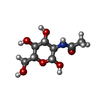

| #1: Protein | Mass: 68476.148 Da / Num. of mol.: 3 Source method: isolated from a genetically manipulated source Source: (gene. exp.)   Homo sapiens (human) / References: UniProt: Q9Z1M0 Homo sapiens (human) / References: UniProt: Q9Z1M0#4: Sugar | ChemComp-NAG / |
|---|
-Non-polymers , 5 types, 218 molecules 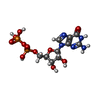

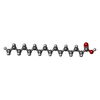

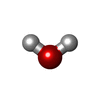




| #2: Chemical | | #3: Chemical | ChemComp-ZN / #5: Chemical | ChemComp-PLM / #6: Chemical | ChemComp-NA / | #7: Water | ChemComp-HOH / | |
|---|
-Details
| Has ligand of interest | Y |
|---|---|
| Has protein modification | Y |
-Experimental details
-Experiment
| Experiment | Method: ELECTRON MICROSCOPY |
|---|---|
| EM experiment | Aggregation state: PARTICLE / 3D reconstruction method: single particle reconstruction |
- Sample preparation
Sample preparation
| Component | Name: Membrane protein / Type: COMPLEX / Entity ID: #1 / Source: RECOMBINANT |
|---|---|
| Source (natural) | Organism:  |
| Source (recombinant) | Organism:  Homo sapiens (human) / Cell: HEK293 GNTI- Homo sapiens (human) / Cell: HEK293 GNTI- |
| Buffer solution | pH: 7 |
| Specimen | Embedding applied: NO / Shadowing applied: NO / Staining applied: NO / Vitrification applied: YES |
| Vitrification | Instrument: FEI VITROBOT MARK IV / Cryogen name: ETHANE |
- Electron microscopy imaging
Electron microscopy imaging
| Experimental equipment |  Model: Titan Krios / Image courtesy: FEI Company |
|---|---|
| Microscopy | Model: TFS KRIOS |
| Electron gun | Electron source:  FIELD EMISSION GUN / Accelerating voltage: 300 kV / Illumination mode: FLOOD BEAM FIELD EMISSION GUN / Accelerating voltage: 300 kV / Illumination mode: FLOOD BEAM |
| Electron lens | Mode: BRIGHT FIELD / Nominal magnification: 130000 X / Nominal defocus max: 1500 nm / Nominal defocus min: 900 nm / Cs: 2.7 mm / C2 aperture diameter: 70 µm |
| Specimen holder | Specimen holder model: FEI TITAN KRIOS AUTOGRID HOLDER |
| Image recording | Electron dose: 45 e/Å2 / Film or detector model: GATAN K3 BIOQUANTUM (6k x 4k) / Num. of real images: 15909 |
| EM imaging optics | Energyfilter slit width: 20 eV |
- Processing
Processing
| EM software | Name: PHENIX / Category: model refinement | ||||||||||||||||||||||||
|---|---|---|---|---|---|---|---|---|---|---|---|---|---|---|---|---|---|---|---|---|---|---|---|---|---|
| CTF correction | Type: PHASE FLIPPING AND AMPLITUDE CORRECTION | ||||||||||||||||||||||||
| Symmetry | Point symmetry: C3 (3 fold cyclic) | ||||||||||||||||||||||||
| 3D reconstruction | Resolution: 2.53 Å / Resolution method: FSC 0.143 CUT-OFF / Num. of particles: 370251 / Symmetry type: POINT | ||||||||||||||||||||||||
| Refine LS restraints |
|
 Movie
Movie Controller
Controller






 PDBj
PDBj


